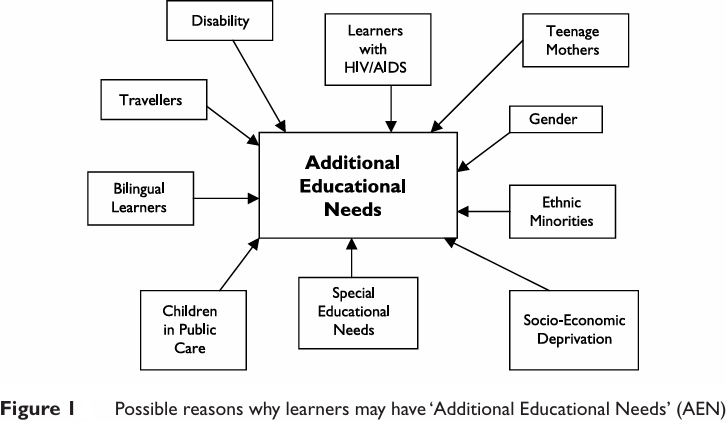
Special Educational Needs (SEN) and Additional Educational Needs (AEN)
 المؤلف:
Sue Soan
المؤلف:
Sue Soan
 المصدر:
Additional Educational Needs
المصدر:
Additional Educational Needs
 الجزء والصفحة:
P4-C1
الجزء والصفحة:
P4-C1
 2025-03-24
2025-03-24
 1698
1698
Special Educational Needs (SEN) and
Additional Educational Needs (AEN)
Some practitioners, quite understandably, are still unaware of the different meanings of SEN and AEN, many assuming that AEN is just a new term for SEN.
So what does SEN mean?
The Special Educational Needs Code of Practice (DfES, 2001a: 6) defines ‘special educational needs’ in the following way:
Children have special educational needs if they have a learning difficulty which calls for special educational provision to be made for them.
The Code of Practice continues to describe a learning difficulty in greater detail and provides explanations of the fundamental principles. It also recognizes that there is a wide spectrum of special educational needs that may be inter-related, but that there are four identified specific areas of need:
■ communication and interaction;
■ cognition and learning;
■ behavior, emotional and social development;
■ sensory and/or physical.
It is important to note at this stage that the National Curriculum Inclusion Statement (QCA/99/458) (and this is statutory) states: ‘All teachers are teachers of SEN’ (QCA, 1999).
What does AEN mean?
An Additional Educational Need (AEN) is the term presently used to define any type of need a learner may be experiencing. It may be that a learner has a SEN and thus he or she can be said to have a SEN Additional Educational Need. However, a learner does not have to have a Special Educational Need to have Additional Educational Needs. An important aspect of providing an inclusive environment for all learners, where differences are valued and respected, is recognizing that learners may have many different additional needs. It is also vital to acknowledge at this stage that these learners’ needs may also change quite frequently, depending on other factors, for example, their age, home situations and peer groups. This means that the learning environment has to be constantly able to change and adapt to its learners’ needs, if they are to be adequately included in the educational setting at all times.

Learners with special educational needs are just one group requiring different and additional support to enable them to access, engage with and participate in learning. There are many other groups of learners that may need specific help and consideration. Examples of possible groups of learners are shown in Figure 1 and these are by no means the only possibilities.
(SEN) and (AEN) Case study
This short case study will highlight the need for a school to look at all the learner’s additional needs and not assume they will be best dealt with by SEN input.
Fatima arrived at the beginning of Year 5 at her local primary school, speaking very little English. External support was very limited and so the head teacher asked the SENCO to help the class teacher by withdrawing Fatima from the class situation during English lessons. Little formal assessment was carried out initially, everyone assuming that her lack of English meant she had learning difficulties. Fatima became unwilling to attend school and very miserable until her actual ability was recognized by an EAL (English as an Additional Language) specialist teacher, who then helped the school with suitable interventions to aid second language development, without inappropriate SEN support.
The Special Educational Needs Code of Practice (DfES, 2001a: 46) actually states that the ‘lack of competence in English must not be equated with learning difficulties’. The class teacher and the SENCO in this case needed to fully assess Fatima’s performance in all lessons and to identify how well she spoke and wrote using her first language. From this information additional language rather than learning difficulty support would have been identified as being needed. As Moore (1999: 177) states: ‘More inclusive schools will value the presence of a wider range of diversity amongst their pupils, celebrating everyone’s contribution within the community.’
Some schools are recognizing the distinction between SEN and AEN by altering or adding new roles. There may now be an Inclusion Manager or an Additional Educational Needs Co-ordinator (AENCO), helping the learners with various needs and supporting the teaching staff, as well as or instead of a Special Educational Needs Co-ordinator (SENCO). Indeed, Moore (ibid.) says:
More inclusive schools will have more inclusive management arrangements with greater sharing of the (SENCO) role. Indeed, the most inclusive schools may have moved away from SEN provision altogether and be fostering more reflective mechanisms which support the development of pedagogy at the classroom/department level.
The National Curriculum 2000 incorporates a statement on inclusion and high-lights the need for this change, emphasizing the importance of providing effective learning opportunities for all pupils by:
■ setting suitable learning challenges;
■ responding to pupils’ diverse needs;
■ overcoming potential barriers to learning and assessment for individuals and groups of pupils.
(DfEE, 2001: 47)
However, to reassure educators, the author believes that the kind of teaching and learning that is good for pupils with AEN is good for ALL children.
Discussion
Look at the learners in your workplace setting. How are their Additional Educational Needs being met, and by whom? Is there a need for a change in roles so that inclusive practice can be developed further? See if you can explain to a colleague the difference between SEN and AEN.
 الاكثر قراءة في Teaching Strategies
الاكثر قراءة في Teaching Strategies
 اخر الاخبار
اخر الاخبار
اخبار العتبة العباسية المقدسة


